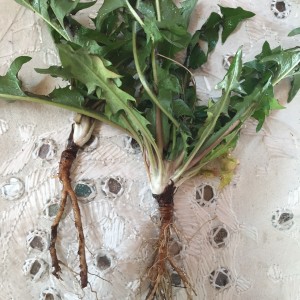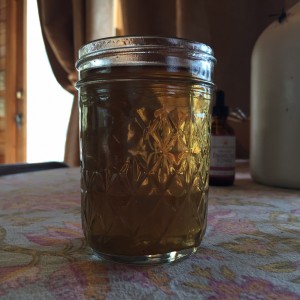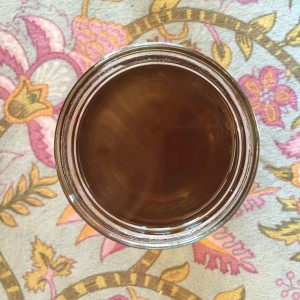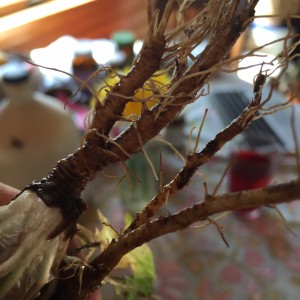|
Category: herbalism
An Ayurvedic Perspective on CBD (Cannabidiol)
Personally, I have experienced a lot of healing using CBD oil. Here in Vermont, CBD is all the rage. It is changing pain management, and mental health treatment options. These are two of the most prominent health issues of our times, so this subject and potential natural herbal support is affecting a lot of people. I have personally used CBD to manage heart pain, postpartum anxiety, and low Ojas, due to high Vata, and I’d like to share my personal story, as well as my understanding on the Ayurvedic energetics of this herbal supplement.
Cannabis was not one of my herbal allies until I found her in this form. Everything can be medicinal, neutral (like foods), or poisonous, from the Ayurvedic perspective, depending on what it does to agni, your digestive fire, and your state of homeostasis (ie: the doshas). This objective way of looking at all substances, or dravya, in terms of their quality, or guna, is really helpful. When choosing foods, herbs or other medicines for bringing you back into balance, the Ayurvedic way is to look at the qualities of the imbalance, and add the opposite qualities to bring balance. This may be especially helpful when there is stigma on certain substances, say eating meat, or in this case, an herbal medicine closely related to an illegal (not so now in Vermont, and quite a few states) drug.
For one, CBD oil is totally legal, and it is not made from marijuana, but hemp (which is the same plant but different chemical make-up.) I have read that marijuana does contain some amount of CBD, maybe 10%, but also has a much higher THC content (which is the chemical in marijuana which is known to be psychoactive, or make you ‘high.’) CBD oil comes from processing the legal hemp plant, in which there are many chemical constituents, including of course, CBD (Cannabidiol), and also very small amounts of THC (Tetrahydro-cannabinol, but amounts around 1% (like kombucha is around 1% alcohol, and no one is getting drunk.)
In Ayurveda, we look at substances, and especially herbs with a few different things in mind. One, are the tastes, the taste on the tongue (rasa, so we know how it affects the doshas), as well as the specific effects on the system (virya): like is it overall heating and catabolic (lightening), or cooling and anabolic (nourishing)? And it the final effect on digestion (vipaka) going to be sweet, sour or pungent as well?
We also look at how a medicine will affect our state of mind. This can be a very obvious affect, as with marijuana, we are very aware of how our mind/psychology is affected, short, and sometimes long term. This is a very special effect, but all substances affect the mind in this way, but perhaps more subtly. The words we use to describe how a substance affects the mind are Sattva, Rajas, and Tamas. In short, sattvic substances increase harmony, peacefulness, clarity and purity of mind, rajasic substance are very action orienting, causing lots of stimulating thoughts, ideas, passion, and action, while tamas is dulling, slow, stagnant and stable, bordering or ignorant at its worst.
We can also look at the 20 gunas, which I will not list all of them here. These can be very physical (like is something light or heavy? Soft or rough?) and experienced through the senses.
Let’s take an Ayurvedic look at CBD
CBD is usually extracted ina base oil, sometimes coconut oil. This addas a bit of sweetness, and the CBD oil itself tastes a bit pungent (katu) and a bit bitter (tikta) to me. It seems to have a warming effect,or Ushna Virya (marijuana does as well.) And I’d say the vipaka is probably also Pungent (Katu.) This is very similar to information I found on Marijuana.
The affect on the mind is mostly Tamasic. Marijuana has a more stimulating, or rajasic effect, which ultimtely turns to Tamas, though with CBD, there is no ‘high’ but more of a downward, slowing, dulling energetic we see in Tamas.
So how does CBD affect the doshas?
Putting this information together, one can see that the overall qualities here end up balancing Vata dosha, and Kapha dosha, perhaps as well, due to it’s heating qualities and bitter taste.
A Vata imbalance is light, rough, dry, erratic, and subtle, seen often in imbalances like anxiety, sharp pain, and insomnia, which many claim CBD helps them heal from. The qualities of CBD seem to be warm, oily, heavy, slow and dull, all opposite of Vata dosha. Some of these qualities balance Kapha dosha, mainly the warming quality.
CBD oil is just starting to be studied in Western medicine. It is known to have an effect on the nervous system, it has been claimed over and over again by individuals who have found true healing from all sorts of pain and inflammation, and many who use this to treat cancer. Not just the side effects of chemotherapy, which has been touted a lot with marijuana (nausea, anorexia, etc) but actually shrinking tumors.
Many claim CBD helps them manage their anxiety, and there is more research regarding how cannabidiol affects our nervous system, in fact, fits right in with our own endocannabinoid system.
CBD and Postpartum Anxiety
A very important part of the nervous system functioning is the Vagus nerve. The vagus nerve runs from the brain to the gut, and “interfaces with parasympathetic control of the heart, lungs, and digestive tract.” The vagus nerve is also very much connected to the uterus, the cervix, and the vagina. And messages move back and forth along the nerve from brain to organ, organ to brain. The ability to relay messages is majorly affected in any sort of trauma.
When the vagus nerve is overstimulated, heart pain and palpitations, irregular heartbeat, fainting, sweating, nausea, and digestive problems can show up. I found these two pieces of information on Wikipedia I find helpful:
“Excessive activation of the vagal nerve during emotional stress, which is a parasympathetic overcompensation of a strong sympathetic nervous system response associated with stress, can also cause vasovagal syncope due to a sudden drop in cardiac output, causing cerebral hypoperfusion. Vasovagal syncope affects young children and women more than other groups.” (Wikipedia)
Vagus Nerve Stimulation “may also be achieved by one of the vagal maneuvers: holding the breath for a few seconds, dipping the face in cold water, coughing, or tensing the stomach muscles as if to bear down to have a bowel movement.” (Wikipedia)
All of this Western A&P is leading me to understanding how childbirth is a natural trauma to the body, and that from the Ayurvedic understanding, this trauma is very much related to Vata-like qualities and symptoms. In Ayurveda, childbirth is one of the most powerful actions of Vata dosha. And again, though natural, psto partum is also a time where Vata qualities are so high and so strong, that extreme Vata balancing measures must be taken, or their is a very high chance for Vata to become high/imbalanced. In a person no matter their constitution. This is why there is a whole 40-day protocol for post partum in Ayurveda, and that is a hole topic itself!
My story, in short
I was blessed with an uncomplicated home birth with my son. Even so, I definitely use the word trauma to describe the process. And even though I had some help, like a supportive husband, and family, and Ayurvedic post-partum knowledge, I made decisions which did not always serve me. As most of us do now and then – with familial, cultural and social pressures all around us, when we are in our most vulnerable state, it’s hard to doctor ourselves.
I had anxiety which started while I was pregnant – but I had never experienced it before, so I didn’t really know what it was. It’s also easy to make a blanket diagnosis, but everything is quite complex, of course, and every individual is different. After my son was born, I had another anxiety attack on day 3. And I had quite regular moments of feeling like ‘I was in hell’ because I could not stop by anxious feeling. I couldnt walk with him in the stroller or in the wrap without stopping every 30 seconds to check if the is breathing.
I think much of this is ‘normal’ for first time moms. But some of the anxiety/exhaustion/mental angst was just unbearable. And when it only continued after his first birthday, and my exhaustion got worse and worse, I was desperate to heal.
This is when I stepped up my self care, I started making decisions that prioritized my own health, and then decided I needed to try something else, or reach for Western medication. I had heard quite a bit about CBD, and wanted to give it a try. Marijuana was not something I wanted to try – I didn’t want to be high – and the THC wasn’t relaxing for me, but paranoia inducing. (May herbs tend to have an opposite reaction than they usually do in others, like, Ashwagandha, t00, is not relaxing for me, but overheating). I was still breastfeeding my son at the time, but just 3 times per day.
I started with a dropper purchased from Blue Bird Botanicals, and then found a local supplier, Green Mountain CBD. I started taking the oil daily, 1 to 3 times, at the end of May, and took it for about 6 weeks daily. After I started taking it regularly, I only had one anxiety attack within about a month. And after that passed, I literally felt like grace descended upon me, and that somewhere inside, a healing switch had been turned on. That I had been shifted over to the parasympathetic side of my nervous system, out of the sympathetic, or stress response, so that I could finally do some deep healing.
Only once did I feel like perhaps I took too much, and I started to get a little spacy, or notice that I was saying far-out things, that maybe were only relevant in my head, but not in my company’s…a little bit like being high. I can definitely tell it makes me sleepy – but when I was so tired before it was already my natural state of being, that I didn’t notice that much of a difference. What I did notice is that I just felt like myself. I felt like I was getting myself back.
Along with that deep center of healing that I felt was finally able to occur, I also felt that the dull quality, and the slow, stable qualities of the herb, were protecting me, softening and soothing the edges of a very raw aura that was ripped open during my son’s birth. This perhaps is where the tamasic quality comes in – tamas may sound ‘bad’ but again, anything can be medicinal depending on what qualties are needed at the time. I was raw and open, very subtle and clear, perhaps too much so, and my mind was also too active and uncontrolled. The dull, closed off, stagnant qualities of the tamasic substance helped me slow down the sensory input and digest the really rich experiences I had had and was having. These same qualities were soothing my ‘tired and so wired I can’t rest’ feeling that sometimes happened to me in the afternoons, and supported me overall with deeper sleep at night. Since I had night weaned my son, it was taking my body a while to get back into a solid night’s sleep.
Thought Tamas is not something one wants to over-do, as with anything, past a dipping point, it could bring too much heaviness or darkness, sliding over into depression, close-mindedness, or indifference.
And now
As I mentioned, I took the CBD, about 20-60 mg per day, for 6 weeks. Then I felt like I was able to take it just daily or situationally as needed. I did not noticed any help with menstrual cramps, nor with inflammation – and in fact, I had some inflammatory conditions come up after I took it in large amounts (curious, perhaps due to its pungent/heating nature, my constitution, and Summer season.)
And here I am about 8 months after that. And I still carry the lessons learned from pregnancy, birth, and mothering. Of course. And I am so grateful for my experiences. But I feel like I have finally returned. And I feel like I have this special ally in my back pocket, and I know when to use it, and when perhaps to choose a softer ally, or one more balancing for my Pitta nature. I am going to learn more about its effects in pregnancy and breastfeeding, because, if I do it all over again, I hope to be able to use this herb responsibly again.
I do not see this as a cure all, though I recommend it casually to a lot of moms struggling with PPA and considering Western medication. My class, Essential Ayurveda for Women, I talk about my other three vital self healing, and deeply nourishing necessities for balancing Vata dosha – oil massage, herbal infusions (nettle, etc) and daily breathwork – and CBD has been a potent number 4, but is not a daily practice now.
Post partum anxiety and depression are such huge and important topics. Thanks you for witnessing part of my story. I’d be glad to hear yours, and if you have any questions about healing and or CBD. Reach out.
Simple Herbalism | Spring Blood Cleanse
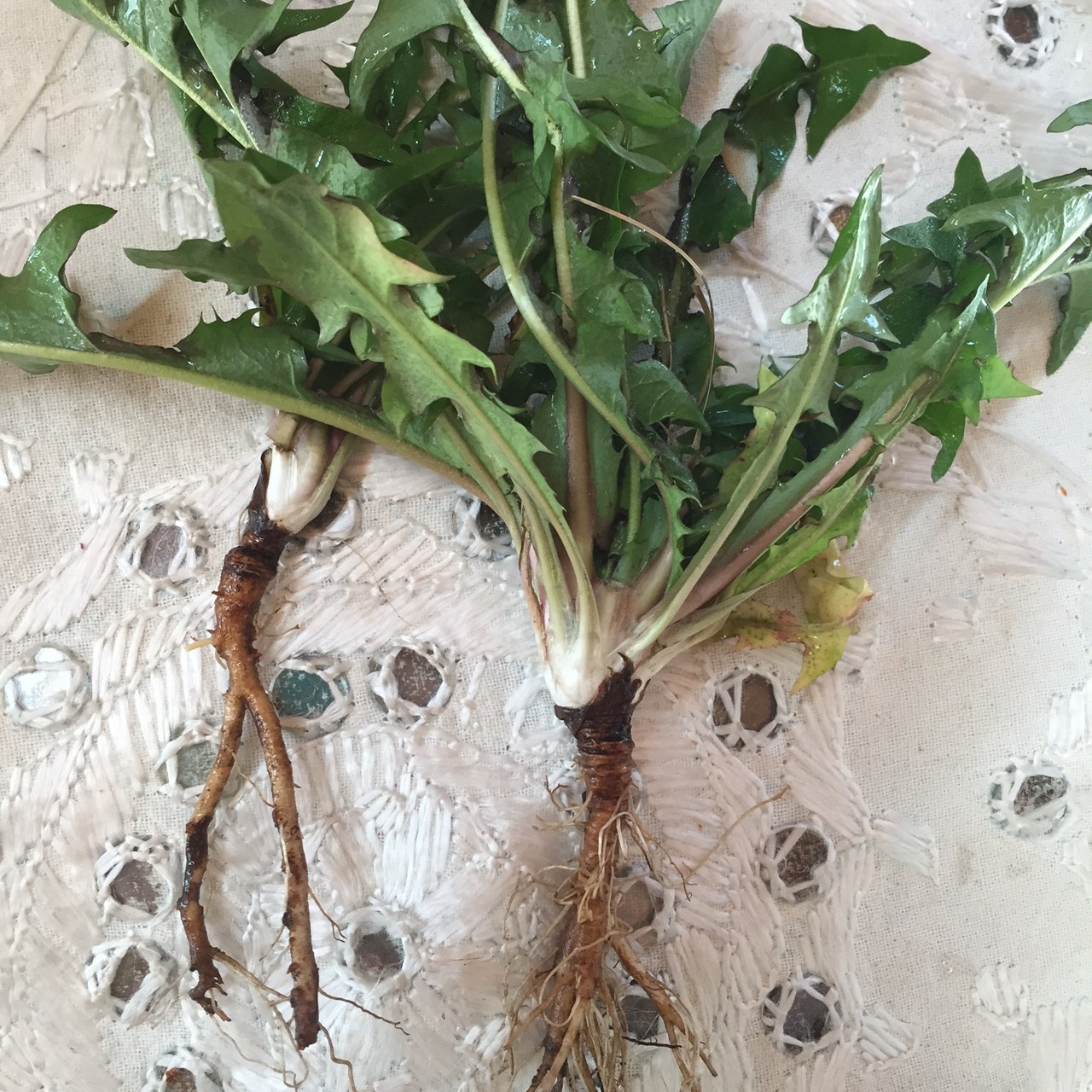
Spring Medicine
As soon as Spring arrives, I start looking for the familiar spiked dandelion leaves in my lawn. It’s finally time for me to make a simple Spring medicine – dandelion root decoction. Though I study Ayurveda, and mostly use Indian herbs in my practice, even Ayurveda says that the closest medicine is always the best medicine. And how much closer can you get than right out the front door?
Using herbs does not have to be complicated – though, I will say, it pays to work with an expert for most. There are some key weeds though, that are easy to use and pretty much completely safe for anyone and everyone. I am in love with Guido Mase’s book, The Wild Medicine Solution, in which he outlines those herbs, or families or herbs, which are safe and useful to all. Dandelion is included in here.
I use dandelion root as a decoction. This is like making a very strong tea. When using herbs in this way, as a freshly made, water-based solution, it’s most helpful to do so regularly over a certain period of time, so the blood, the body, becomes saturated with the subtle medicine. So that the system is constantly bathed with the energetics of the substance. This takes some attention, and for me in the Spring, becomes like a daily intention or ritual.
Energetics of Dandelion
The late Spring, according to the Ayurvedic calendar and rtucharya, is an overlapping of Kapha and Pitta gunas (qualities). Kapha qualities of late Winter and Spring like wet, cold, and heaviness fluctuate with the increasing Pitta qualities in the environment, like heat and sharpness. (Sharp is an interesting quality to consider in your environment – I relate to this right now as the bright Spring sunlight finally comes into contact with my winter white skin and delicate eyesight…)
The taste that bring balance to all of these qualities is bitter, or tikta. Remembering that the tastes contain the elements, and that the elements are what make up the doshas. And also remembering that like increases like in Ayurveda, so when looking to balance out the powerful external influences, the season, on our physiology, we choose foods and medicines with opposite qualities.
Kapha is made up of the water and earth elements, and Pitta is made up of fire and water. Bitter taste is said to contain mostly space and air. The space and air elements bring the quality or dry, light, and clear, which balance the qualities found in our environment at this time of year. Dandelion roots, as well as leaves, are a lovely, palatable bitter food/herb. So this makes dandelion the perfect Spring medicine according to Ayurvedic principles – though you may not call in an ‘Ayurvedic herb.’ Whatever that means 🙂
Something I love about Spring dandelions is that they are not all bitter. Use your tongue – there is most certainly a softness and a sweetness to the brew. I believe this makes the Spring tonic less aggravating for Vatas and Vata imbalances.
Why do it?
These doshas can affect us differently, of course, depending on our own constitution. But things that are considered ‘normal abnormalities’ in late Spring include allergies, hives, eczema, skin rashes or itching, red eyes, and irregular digestive stuff going on (whether slow or sluggish, or fluctuating between constipation and loose.) These symptoms can be connected to the doshas mixed with ama, a toxin that is created when our digestion is out of wack. And if digestion is out of wack, as in the case of the examples above, more toxins can be created. This toxin can easily become absorbed into the blood stream, causing skin eruptions, or worsening allergy symptoms.
Dandelion, and most bitters, are considered to benefit the liver and galbladder, which is the organ that cleanses the blood, and aids in digestion through the production of bile – in Ayurveda, blood is referred to as rakta dhatu. The liver has numerous, numerous functions – another one being, as it filters the blood, it aids in the breaking own of hormones. The gallbladder helps us digest our food properly by releasing digestive enzymes. In Ayurveda, we would translate this as agni, part of our digestive capacity.
So, dandelion can benefit us in many ways. The bitter quality of dandelion cools and blood, and aids in proper functionality of the liver, leading to less inflammation, inside and outside. And by improving the flow of bile, we may digest our food better. And when we digest our food better, we create less toxins to begin with, as well as have less daily discomfort. And we all know that digestion is the crux of health and healing in Ayurvedic medicine.
Did you do a cleanse this Spring?
Some of you have already done your Spring cleansing ritual. And some of you joined my Ayurvedic Cleanse a couple of weeks ago. Making a dandelion decoction is a way to extend the benefits and continue to slowly metabolize toxins, and get a jump on Summer Pitta flare ups.
Here’s how I do it:
As soon as I see the dandelion greens pop up in my garden, I go out with the shovel and dig up one of two. Be sure to get deeper than you think, and come up with your tool underneath the plant. Shake away the dirt from the root (and earthworms!) and bring them inside with you.
Wash the whole plant under cool water. Fill a pot full with fresh water. Don’t worry about the exact ratio – but I use a smaller pot, adding about 3-4 cups of water.
Chop the roots roughly, and add roots and leaves to the water. Both parts of the plant have medicinal qualities – the leaves tend to be more of a diuretic, working on the kidneys, and the root, the liver and blood. Both get more and more bitter as the season progresses.
Alternately, you may save the leaves (wash them well!) for a simple bitter salad.
Simmer this concoction over medium low heat until the water is reduced by half. This concentration ratio is considered a decoction, and is much stronger than a tea. Strain and drink, or you may also cool this before drinking – it’s a great room temperature tea.
The next morning, dig up another root or two, and repeat. Leave the previously boiled root and leaf in their for a day or two, then strain and compost.
Feel free to drink up to 2 cups per day. About what you’ll probably yield.
*Be sure that where you are harvesting your dandelions they are NOT SPRAYED or treated with chemical fertilizers!
If you have pitta imbalances in the Summer time, like hay fever, hives, heat rashes, acne, boils, loose stools, hormonal imbalances, heavy menstrual bleeding, or a lot of irritability, start using this medicine now, and see how your season will change.
If you want to learn more about using food as medicine this Summer, join my ECourse for Pitta dosha, which begins on June 5th. Registrations just opened. Many of you have asked for more introductory courses in Ayurveda, and I’m answering!
Love,
Red Clover Infusion
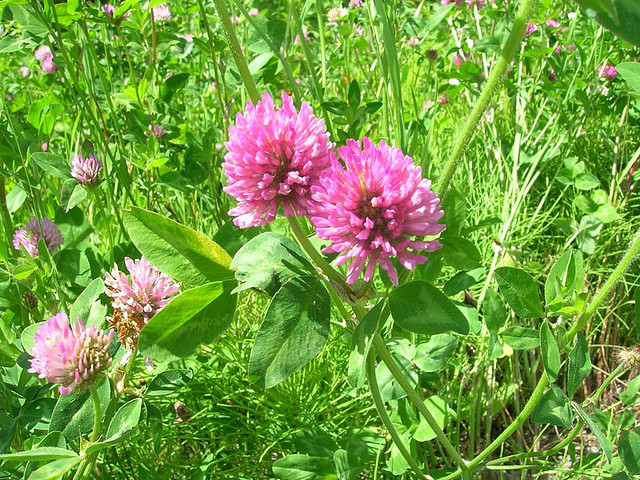
Since the dandelions have sprung up, I have been picking a few new roots everyday and making decoction fresh daily. It’s been most of my Spring cleansing, and really uprooting any of the discoloration underneath my skin leftover from the bout of eczema I experienced in February.
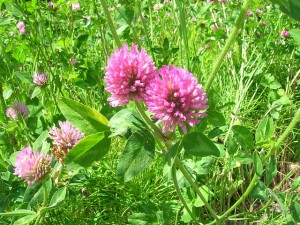 Nature’s next medicine just arrived (for me and the bees!): Red Clover. Red Clover is a very delicate, astringent and slightly sweet herb. This makes it great for Pitta, as the weather gets warmer and the light strongest as we approach Summer Solstice.
Nature’s next medicine just arrived (for me and the bees!): Red Clover. Red Clover is a very delicate, astringent and slightly sweet herb. This makes it great for Pitta, as the weather gets warmer and the light strongest as we approach Summer Solstice.
I’m lucky to have clover opening in the field behind and in front of my house, and all along the road. The reddish pink blossoms can’t be missed. My husbands beehive is growing exponentially since they have bloomed – soon enough we will extract the first honey of the season made from that red clover nectar, processed through little magical buzzing beings.
So my morning (and sometimes late afternoon) ritual has involved filling a large mason jar with red clover blossoms, and then making an infusion which I then strain and sip throughout the day. Just cover the clover with boiling water, and remember to cover – if you’re filling a mason jar, put the lid on, or cover with a small plate. Steep this way for at least 20 minutes, strain and drink warm or cool.
Clover is a great blood cleanser. This means it can help with acne, rashes, and headaches, anger, hot flashes, and excess menstrual bleeding.
I am learning and personally experiencing so much by trying these local herbs on myself. I’m enjoying noticing how the gunas/qualities and the elements are expressing themselves in my environment as the season changes. I am almost blown away by the abundance of green, greens and resources there are around us so quickly after the winter leaves.
What are you noticing in your body as the weather shifts? Have you tried Red Clover tea? What were you using it for?
Love, Adena


